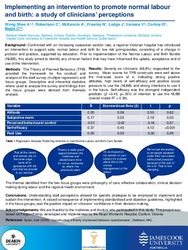Please use this identifier to cite or link to this item:
http://hdl.handle.net/11054/1224Full metadata record
| DC Field | Value | Language |
|---|---|---|
| dc.contributor | Wong Shee, Anna | en_US |
| dc.contributor | Robertson, Carolyn | en_US |
| dc.contributor | McKenzie, AnneMarie | en_US |
| dc.contributor | Frawley, Natasha | en_US |
| dc.contributor | Lodge, Julie | en_US |
| dc.contributor | Versace, Vincent | en_US |
| dc.contributor | Corboy, Denise | en_US |
| dc.contributor | Nagle, Cate | en_US |
| dc.date.accessioned | 2018-09-24T23:25:56Z | - |
| dc.date.available | 2018-09-24T23:25:56Z | - |
| dc.date.issued | 2018 | - |
| dc.identifier.govdoc | 01197 | en_US |
| dc.identifier.uri | http://hdl.handle.net/11054/1224 | - |
| dc.description.abstract | Background: Confronted with an increasing caesarean section rate, a regional Victorian hospital has introduced an intervention to support safe, normal labour and birth for low risk primigravidas, consisting of a change in protocol and practice, supported by education. Prior to implementation of the Normal Labour and Birth Bundle (NLBB), this study aimed to identify any clinician factors that may have influenced the uptake, acceptance and of use of the intervention. Method: The Theory of Planned Behaviour (TPB) provided the framework for the conduct and analysis of the staff survey and focus groups. Descriptive and inferential statistics where used to anlayse the survey and findings from the focus groups were derived from thematic analysis. Results: Seventy-six clinicians (88.8%) responded to the survey. Mean scores for TPB constructs were well above the mid-scale score of 4, indicating strong positive attitudes, high levels of self-efficacy and positive social pressure to use the (NLBB) and strong intentions to use it in the future. Self-efficacy was the strongest independent predictor (β =0.48, p<.05) of intention to use the NLBB. The themes identified from the two focus groups were philosophy of care, effective collaboration, clinical decision making during labour and the regional health environment. Conclusions: Understanding staff perceptions allowed for specific strategies to be employed to implement and sustain the intervention. | en_US |
| dc.description.provenance | Submitted by Gemma Siemensma (gemmas@bhs.org.au) on 2018-09-24T23:25:39Z No. of bitstreams: 1 PSANZ2018 poster.pdf: 268147 bytes, checksum: f41a8a408f529e67aba4b436aed6c3e9 (MD5) | en |
| dc.description.provenance | Approved for entry into archive by Gemma Siemensma (gemmas@bhs.org.au) on 2018-09-24T23:25:56Z (GMT) No. of bitstreams: 1 PSANZ2018 poster.pdf: 268147 bytes, checksum: f41a8a408f529e67aba4b436aed6c3e9 (MD5) | en |
| dc.description.provenance | Made available in DSpace on 2018-09-24T23:25:56Z (GMT). No. of bitstreams: 1 PSANZ2018 poster.pdf: 268147 bytes, checksum: f41a8a408f529e67aba4b436aed6c3e9 (MD5) Previous issue date: 2018 | en |
| dc.title | Implementing an intervention to promote normal labour and birth: a study of clinicians’ perceptions. | en_US |
| dc.type | Conference | en_US |
| dc.type.specified | Poster | en_US |
| dc.bibliographicCitation.conferencedate | March 25-28th | en_US |
| dc.bibliographicCitation.conferencename | PSANZ2018 – Perinatal Society of Australia and New Zealand Annual Scientific Meeting | en_US |
| dc.bibliographicCitation.conferenceplace | Auckland, New Zealand | en_US |
| dc.subject.healththesaurus | PREGNANCY | en_US |
| dc.subject.healththesaurus | LABOUR | en_US |
| dc.subject.healththesaurus | BIRTH | en_US |
| dc.subject.healththesaurus | STAFF PERCEPTIONS | en_US |
| dc.subject.healththesaurus | CAESAREAN | en_US |
| dc.subject.healththesaurus | REGIONAL | en_US |
| Appears in Collections: | Research Output | |
Files in This Item:
| File | Description | Size | Format | |
|---|---|---|---|---|
| PSANZ2018 poster.pdf | 261.86 kB | Adobe PDF |  View/Open |
Items in DSpace are protected by copyright, with all rights reserved, unless otherwise indicated.
